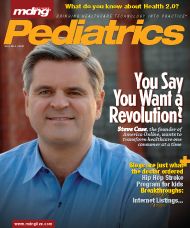4 Questions with... Olajide Williams, MD, MS, Director of the Harlem Stroke Initiative for children
Dr. Williams explains the Hip Hop Stroke Program, the purpose of its development, and the success it's seen.
Dr. Williams explains the Hip Hop Stroke Program, the purpose of its development, and the success it’s seen.
1 What is the Hip Hop Stroke Program™?
The idea was conceived by the National Stroke Association in 2005, and I was asked to help develop and pilot the program. I was looking for ways to combat stroke in central Harlem, NY, which is an under-served and low-income community plagued by health disparities and poor outcomes predominantly from a number of preventable diseases, including cardiovascular and cerebrovascular diseases. Hip Hop Stroke is a great program, because it’s very unique in its approach to stroke recognition and prevention. Whenever people hear about stroke and children, they wonder, “What do children have to do with stroke, and what does stroke have to do with children?” The thinking behind Hip Hop is to teach the children how to recognize the signs and symptoms of stroke and encourage them to engage their family members and really serve as first responders at home. We have two modules: the first is a one-hour program for one day; the second is one hour for three days. Traditionally, adults educate children, but with Hip Hop Stroke, we’re trying to have the children educate adults by taking the message home. There are many examples of how children influence their parents, but it hasn’t really been employed in the healthcare industry. We’ve had great success, and the kids are reaching their parents, grandparents, and caregivers.
2 What is the secret to effectively teaching kids about stroke?
The key to the program’s success is to have a really exciting and motivating program for the kids; the program is for third-to-eighth graders. Herein lies the beauty of hip hop music; kids love it. They are so energized and engaged by this music, it was a no-brainer to try to use the excitement that hip hop generates in a positive form. By taking that excitement and weaving it into a public health program, it has the potential of truly educating children about a specific health issue. We’ve trained more than 4,000 children in central Harlem alone.
We teach the children a simple mnemonic—FAST—that they can use to recognize stroke and act appropriately. F stands for Face; you ask the individual to smile and if one side of the face is drooped down and crooked, that might be a sign of a stroke. A stands for Arm; you ask the person to raise both arms, and if one doesn’t go up, that might be a sign. S stands for Speech; you ask the individual to say a simple sentence, and if the speech is slurred, that might be a sign. T stands for Time to call 911. We wanted to find a hip hop artist to work with and were very fortunate to find Doug E. Fresh, who has actually written children’s books for Scholastic. He’s very popular and is considered a hip hop legend and icon. We were able to have Doug E. Fresh become a full participant and help incorporate the hip hop music into the program. He wrote the songs with my help. We took the five cardinal symptoms of stroke and built them into a rap song with a chorus that goes “Call 911, Call 911! Brain attack, Brain attack! Call 911!” It’s an interactive song with a catchy beat. Most of the children who’ve been through our program can rap the lyrics without realizing that they are actually learning the symptoms of stroke.
3 Can you share some success stories?
A fourth grader recognized stroke symptoms in his grandparent and called 911, getting his grandparent to the hospital in time for emergency stroke treatment. A sixth grader from a different school was at a subway station in the Bronx and an elderly lady dropped her groceries on the platform. He rushed over to her and after asking a few questions, recognized she was slurring her speech and called 911. Not only are we seeing the results in terms of the knowledge retention and parents being engaged, we’re also seeing that these children can successfully act as first responders.
4 How are you planning to expand the program?
Once we complete all three stages of the research, and have a comprehensive model that works across all the research, we think we’ll have a module that can be applied to a number of diseases beyond stroke. Right now we have a Harlem module. We’re in the process of developing a citywide module for all of New York and are working with the department of education and the public health system. Once it’s ready, we will have a portable module that can be used in cities across America.
